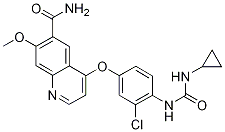All AbMole products are for research use only, cannot be used for human consumption.

Lenvatinib (E7080) is an orally active inhibitor of multiple receptor tyrosine kinases including VEGF, FGF and SCF receptors. Lenvatinib (E7080) has IC50s of 4, 5.2, 22 nM for VEGFR2 (KDR), VEGFR3 (Flt-4), and VEGFR1 (Flt-1), respectively. Lenvatinib inhibits PDGFRα, PDGFRβ, FGFR1, and KIT with IC50s of 51, 39, 46, and 100 nM, respectively. Lenvatinib was found to be transformed to a GSH conjugate, through displacement of an O-aryl moiety, at the quinoline part of the molecule in the liver and kidneys. The GSH conjugate underwent further hydrolysis by γ-glutamyltranspeptidase and dipeptidases, followed by intramolecular rearrangement, to form N-cysteinyl quinoline derivatives, which were dimerized to form disulfide dimers and also formed an N,S-cysteinyl diquinoline derivative.
Oral administration of Lenvatinib inhibited tumor growth of H146 cells at doses of 30 and 100 mg/kg in a dose-dependent manner and caused tumor regression at 100 mg/kg. While anti-VEGF antibody also slowed tumor growth, it did not cause tumor regression. These results indicate that KIT signaling has a role in tumor angiogenesis of SCF-producing H146 cells, and Lenvatinib causes regression of H146 tumors as a result of antiangiogenic activity mediated by inhibition of both KIT and VEGF receptor signaling.

J Virol. 2020 Feb 14;94(5):e01791-19.
Targeting Kaposi's Sarcoma-Associated Herpesvirus ORF21 Tyrosine Kinase and Viral Lytic Reactivation by Tyrosine Kinase Inhibitors Approved for Clinical Use
Lenvatinib purchased from AbMole
| Cell Experiment | |
|---|---|
| Cell lines | H146 cells |
| Preparation method | Proliferation assay H146 (1.2 3 103 cells/50 lL/well) in SFM containing 0.5% BSA were cultured in 96-well multi-plates. After overnight culture at 37℃, SFM (150 lL/well) containing 0.5% FBS and several concentrations of SCF were added with or without several concentrations of compound. After culture for 72 hr, the ratios of surviving cells were measured by WST-1. |
| Concentrations | 0~10 μM |
| Incubation time | 72 hr |
| Animal Experiment | |
|---|---|
| Animal models | Female BALB/c nude mice H146 cells tumor xenograft model |
| Formulation | 0.5% methylcellulose |
| Dosages | 30, 100mg/kg twice a day from day 1 to day 21 |
| Administration | orally |
| Molecular Weight | 426.85 |
| Formula | C21H19ClN4O4 |
| CAS Number | 417716-92-8 |
| Solubility (25°C) | DMSO 12 mg/mL |
| Storage |
Powder -20°C 3 years ; 4°C 2 years In solvent -80°C 6 months ; -20°C 1 month |
| Related VEGFR/PDGFR Products |
|---|
| SU5208
SU5208 inhibits vascular endothelial growth factor receptor-2 (VEGFR2). |
| VEGFR-IN-1
VEGFR-IN-1 is a potent angiogenesis inhibitor with IC50s of 0.02, 0.18, 0.24 7.3, and 7 µM for KDR, Flt-1, c-Kit, EGF-R, and c-Src, respectively. |
| (Z)-Orantinib
(Z)-Orantinib ((Z)-SU6668) is a potent, selective, orally active and ATP competitive inhibitor of Flk‐1/KDR, PDGFRβ, and FGFR1, with IC50s of 2.1, 0.008, and 1.2 µM, respectively. |
| (Rac)-SAR131675
(Rac)-SAR131675 is the racemate of SAR131675. |
| AGL 2043
AGL 2043 is an effective inhibitor of PDGFR (IC50=0.8 μM) and TEL-PDGFR kinases, as well as FLT3 and KIT kinases. |
All AbMole products are for research use only, cannot be used for human consumption or veterinary use. We do not provide products or services to individuals. Please comply with the intended use and do not use AbMole products for any other purpose.


Products are for research use only. Not for human use. We do not sell to patients.
© Copyright 2010-2024 AbMole BioScience. All Rights Reserved.
